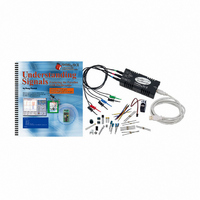28119 Parallax Inc, 28119 Datasheet - Page 10

28119
Manufacturer Part Number
28119
Description
KIT UNDERSTANDING SIGNALS
Manufacturer
Parallax Inc
Datasheet
1.28119.pdf
(137 pages)
Specifications of 28119
Lead Free Status
Contains lead
Accessory Type
Oscilloscope
Interface Type
USB
For Use With/related Products
BASIC Stamp® 2 and Board of Education
Lead Free Status / Rohs Status
Lead free / RoHS Compliant
Available stocks
Company
Part Number
Manufacturer
Quantity
Price
Company:
Part Number:
281197-2
Manufacturer:
TE
Quantity:
20 000
Company:
Part Number:
281197-2
Manufacturer:
MOLEX
Quantity:
2 500
- Current page: 10 of 137
- Download datasheet (5Mb)
Figure 1-2 provides an example of 1 ms (millisecond) of time, read from left to right. To
accomplish this, the oscilloscope samples the input signal, or waveform, at a very specific
rate called the sample rate. The OPTAscope has a maximum sample rate of one million
samples per second, (1Ms/s) when using one channel, half that when using both channels
at once. The sample rate is the limiting factor that determines the maximum signal
frequency that the OPTAscope can capture and display. This means that, with the
OPTAscope, you can view any sine wave with a frequency of 60 kHz or less. Square
waves can be viewed if they are 100 kHz or less. In either case, using the Zoom feature
produces nice waveform images even at these extreme speeds.
HOW DOES AN OSCILLOSCOPE WORK?
We have said that digital oscilloscopes sample and record signals, and then display these
signals for viewing. Functionally, this is very similar to a simple datalogger. The
difference between the two is that dataloggers record data all of the time, but
oscilloscopes may be triggered to store data at particular times.
Figure 1-2:
OPTAscope 1Ms/s
example.
Here is an example
of the output of the
OPTAscope. It is
displaying the
characteristics of
two signals during
the same period of
1 ms.
This dual signal
display ability
allows you to see
what the signals
look like and their
relationship to each
other - very
important in some
applications.
Related parts for 28119
Image
Part Number
Description
Manufacturer
Datasheet
Request
R

Part Number:
Description:
Microcontroller Modules & Accessories DISCONTINUED BY PARALLAX
Manufacturer:
Parallax Inc

Part Number:
Description:
BOOK UNDERSTANDING SIGNALS
Manufacturer:
Parallax Inc
Datasheet:

Part Number:
Description:
COMPETITION RING FOR SUMOBOT
Manufacturer:
Parallax Inc
Datasheet:

Part Number:
Description:
TEXT INFRARED REMOTE FOR BOE-BOT
Manufacturer:
Parallax Inc
Datasheet:

Part Number:
Description:
BOARD EXPERIMENT+LCD NX-1000
Manufacturer:
Parallax Inc
Datasheet:

Part Number:
Description:
CONTROLLER 16SERVO MOTOR CONTROL
Manufacturer:
Parallax Inc
Datasheet:

Part Number:
Description:
BASIC STAMP LOGIC ANALYZER
Manufacturer:
Parallax Inc
Datasheet:

Part Number:
Description:
IC MCU 2K FLASH 50MHZ SO-18
Manufacturer:
Parallax Inc
Datasheet:















